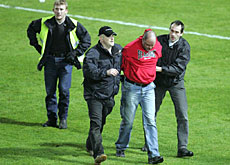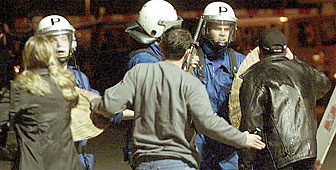Clubs and police tackle ice hockey violence

Violence and offensive behaviour are increasingly becoming the norm at hockey games, a trend that is causing concern to clubs, police and genuine fans.
With more than 50,000 people due to attend ice hockey games every week from September to April, the Swiss Ice Hockey Association (SIHA) has prioritised the fight against violence this season.
In a statement issued at the start of the season, the SIHA said troublemakers were interfering with the game and “putting the security of the players, officials and spectators at risk”.
The SIHA promised to intervene decisively against badly behaved fans and in cases where security regulations are breached. Banners or chants with offensive or racist content will no longer be tolerated.
Patrick Reber, spokesman for the SIHA, says clubs are no longer prepared to pay thousands of francs in fines for troublemakers throwing objects and setting off fireworks and smoke bombs in their stands.
“Up to now we have not identified individuals but that is our next step. Clubs are responsible for the games, they have to pay fines to the association. So it makes sense to figure out who the troublemakers are and make them pay,” he told swissinfo.
The problem of violence in ice hockey was dramatically brought to light in April 2001 by ugly scenes at the end of the championship final between Lugano and the Zurich Lions, when players came under attack.
Frequent violence
The 2004 Federal Police Office report on internal Swiss security, published in May of this year, confirmed a “net increase” in outbursts of violence at ice hockey and football matches.
“Acts of violence are becoming more and more frequent in the lower leagues and in smaller sized clubs and stadiums,” the report states.
“Under the cover of anonymity, a growing number of people who have little interest in sport are operating in a violent manner.”
The head of a federal police taskforce against hooliganism, Christoph Vögeli, says the ice hockey authorities have reacted well to the problem. Every club now has a fan delegate who liaises between the club and the fans.
Isabelle Mauron is the fan delegate for Fribourg-Gottéron, representing ten clubs and 700 fans. She comes to the club almost every day and acts as an intermediary between the club and the fans.
“I’ve been a fan for 25 years and the fan delegate for five years. It’s not a paid position at Fribourg and it takes up a huge amount of my time,” she said.
Mauron knows almost all the affiliated fans by sight and can find out their names if necessary. “We have a little group who call themselves ‘ultras’, founded in 2002. We try to work in close cooperation with the club security to keep an eye on them.”
“The problem is growing and there are a few people we find hard to control. Sometimes violence does break out, even between Gottéron fans. Then we single them out and ban them for a year.”
Looking for action
Vögeli explains that there is a difference between fully-fledged hooligans and fans who occasionally embrace violence. “Hooligans are militant people who look for like-minded rivals to engage in rioting and fighting together. We do not have a big problem with this category in Swiss stadiums.”
Young violence opportunists aged between 15 and 25 are more prevalent. “They are not afraid of violence, and they are likely to attack normal fans. They’re looking for experience and action and they take out their aggression on the police and security forces.”
The police strategy against violence in sport is to take away anonymity from violent fans, says Vögeli. “Over time we have confirmed that violence thrives in an anonymous environment and as soon as that cloak is taken away, the inhibition threshold rises once again.”
Another measure is to have a strong presence and strict entrance security at every game. “We monitor the militant scene and make checks so that people have to reveal their identities,” said Vögeli.
Mauron regrets the loss of fun in the sport. “It never used to be this bad; we used to be next to each other without a problem.”
“Now we have barriers between the fans and we are caged in like animals. It’s very sad and gives the impression even more that the rival fans are the enemy.”
Measures against violence in ice hockey:
Identifying troublemakers through better entrance security, surveillance cameras and security presence in the stands.
Offensive chants and banners no longer tolerated.
Ban on throwing objects and setting off fireworks and smoke bombs.
Maintaining a line of contact with fans through fan delegates.
Clubs intend to pass on fines to troublemakers.

In compliance with the JTI standards
More: SWI swissinfo.ch certified by the Journalism Trust Initiative











You can find an overview of ongoing debates with our journalists here . Please join us!
If you want to start a conversation about a topic raised in this article or want to report factual errors, email us at english@swissinfo.ch.